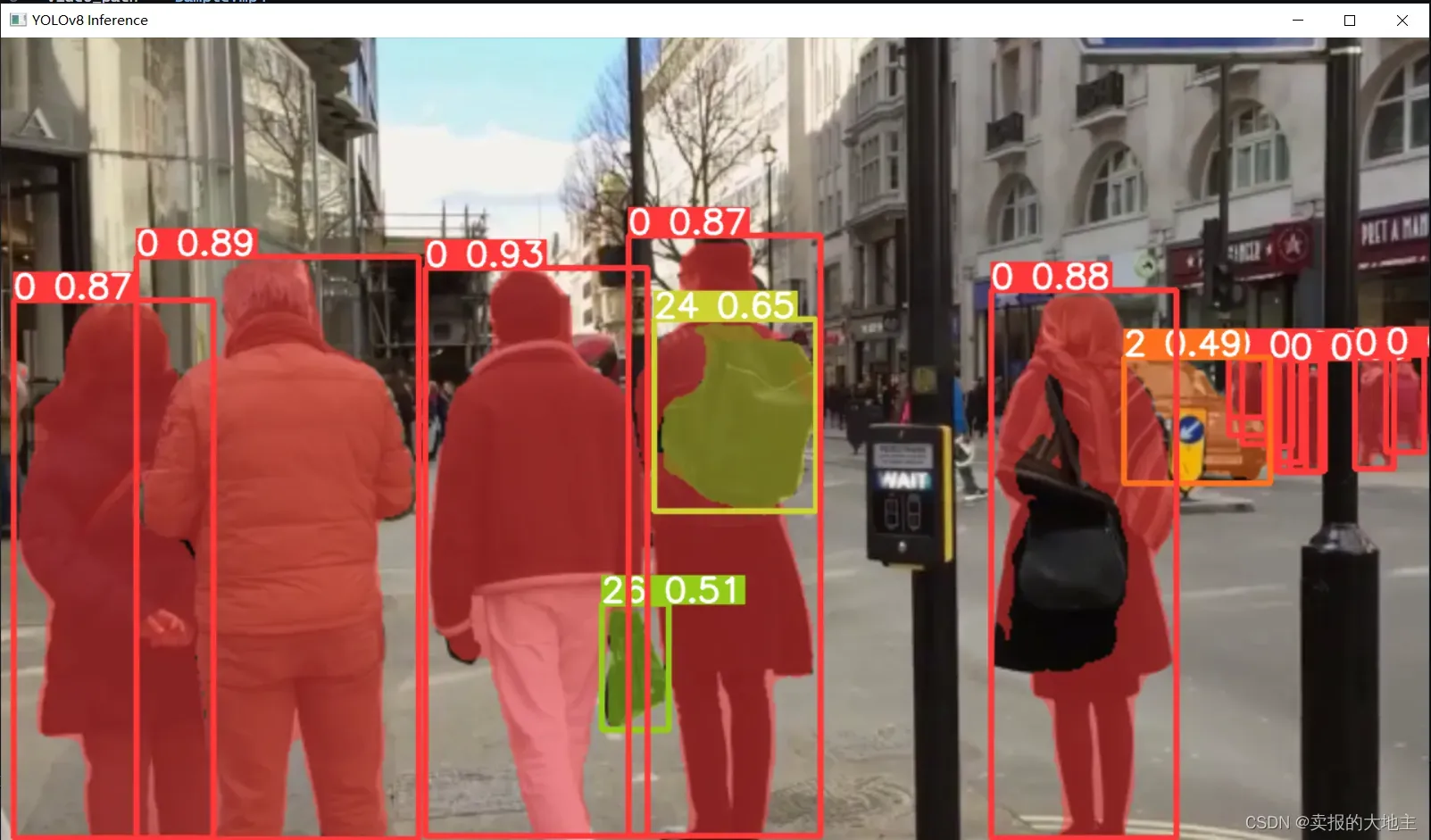predict模式用于在新图像或视频上使用经过训练的YOLOv8模型进行预测,在此模式下,模型从checkpoint 文件加载,用户可以提供图像或视频来执行推理。模型预测输入图像或视频中对象的类别和位置。
from ultralytics import YOLO
from PIL import Image
import cv2
model = YOLO("model.pt")
# 接受所有格式-image/dir/Path/URL/video/PIL/ndarray。0用于网络摄像头
results = model.predict(source="0")
results = model.predict(source="folder", show=True) # 展示预测结果
# from PIL
im1 = Image.open("bus.jpg")
results = model.predict(source=im1, save=True) # 保存绘制的图像
# from ndarray
im2 = cv2.imread("bus.jpg")
results = model.predict(source=im2, save=True, save_txt=True) # 将预测保存为标签
# from list of PIL/ndarray
results = model.predict(source=[im1, im2])
YOLOv8预测模式可以为各种任务生成预测,在使用流模式时返回结果对象列表或结果对象的内存高效生成器。通过在预测器的调用方法中传递stream=True来启用流模式。stream=True的流媒体模式应用于长视频或大型预测源,否则结果将在内存中累积并最终导致内存不足错误。
inputs = [img, img] # list of numpy arrays
results = model(inputs, stream=True) # generator of Results objects
for result in results:
boxes = result.boxes # Boxes object for bbox outputs
masks = result.masks # Masks object for segmentation masks outputs
probs = result.probs # Class probabilities for classification outputs
相关参数如下:
| Key | Value | Description |
|---|---|---|
source | 'ultralytics/assets' | source directory for images or videos |
conf | 0.25 | object confidence threshold for detection |
iou | 0.7 | intersection over union (IoU) threshold for NMS |
half | False | use half precision (FP16) |
device | None | device to run on, i.e. cuda device=0/1/2/3 or device=cpu |
show | False | show results if possible |
save | False | save images with results |
save_txt | False | save results as .txt file |
save_conf | False | save results with confidence scores |
save_crop | False | save cropped images with results |
hide_labels | False | hide labels |
hide_conf | False | hide confidence scores |
max_det | 300 | maximum number of detections per image |
vid_stride | False | video frame-rate stride |
line_thickness | 3 | bounding box thickness (pixels) |
visualize | False | visualize model features |
augment | False | apply image augmentation to prediction sources |
agnostic_nms | False | class-agnostic NMS |
retina_masks | False | use high-resolution segmentation masks |
classes | None | filter results by class, i.e. class=0, or class=[0,2,3] |
boxes | True | Show boxes in segmentation predictions |
YOLOv8可以接受各种输入源,如下表所示。这包括图像、URL、PIL图像、OpenCV、numpy数组、torch张量、CSV文件、视频、目录、全局、YouTube视频和流。该表指示每个源是否可以在流模式下使用stream=True✅以及每个源的示例参数。
| source | model(arg) | type | notes |
|---|---|---|---|
| image | 'im.jpg' | str, Path | |
| URL | 'https://ultralytics.com/images/bus.jpg' | str | |
| screenshot | 'screen' | str | |
| PIL | Image.open('im.jpg') | PIL.Image | HWC, RGB |
| OpenCV | cv2.imread('im.jpg')[:,:,::-1] | np.ndarray | HWC, BGR to RGB |
| numpy | np.zeros((640,1280,3)) | np.ndarray | HWC |
| torch | torch.zeros(16,3,320,640) | torch.Tensor | BCHW, RGB |
| CSV | 'sources.csv' | str, Path | RTSP, RTMP, HTTP |
| video ✅ | 'vid.mp4' | str, Path | |
| directory ✅ | 'path/' | str, Path | |
| glob ✅ | 'path/*.jpg' | str | Use * operator |
| YouTube ✅ | 'https://youtu.be/Zgi9g1ksQHc' | str | |
| stream ✅ | 'rtsp://example.com/media.mp4' | str | RTSP, RTMP, HTTP |
图像类型
| Image Suffixes | Example Predict Command | Reference |
|---|---|---|
| .bmp | yolo predict source=image.bmp | Microsoft BMP File Format |
| .dng | yolo predict source=image.dng | Adobe DNG |
| .jpeg | yolo predict source=image.jpeg | JPEG |
| .jpg | yolo predict source=image.jpg | JPEG |
| .mpo | yolo predict source=image.mpo | Multi Picture Object |
| .png | yolo predict source=image.png | Portable Network Graphics |
| .tif | yolo predict source=image.tif | Tag Image File Format |
| .tiff | yolo predict source=image.tiff | Tag Image File Format |
| .webp | yolo predict source=image.webp | WebP |
| .pfm | yolo predict source=image.pfm | Portable FloatMap |
视频类型
| Video Suffixes | Example Predict Command | Reference |
|---|---|---|
| .asf | yolo predict source=video.asf | Advanced Systems Format |
| .avi | yolo predict source=video.avi | Audio Video Interleave |
| .gif | yolo predict source=video.gif | Graphics Interchange Format |
| .m4v | yolo predict source=video.m4v | MPEG-4 Part 14 |
| .mkv | yolo predict source=video.mkv | Matroska |
| .mov | yolo predict source=video.mov | QuickTime File Format |
| .mp4 | yolo predict source=video.mp4 | MPEG-4 Part 14 – Wikipedia |
| .mpeg | yolo predict source=video.mpeg | MPEG-1 Part 2 |
| .mpg | yolo predict source=video.mpg | MPEG-1 Part 2 |
| .ts | yolo predict source=video.ts | MPEG Transport Stream |
| .wmv | yolo predict source=video.wmv | Windows Media Video |
| .webm | yolo predict source=video.webm | WebM Project |
预测结果对象包含以下组件:
Results.boxes: — 具有用于操作边界框的属性和方法的boxes
Results.masks: — 用于索引掩码或获取段坐标的掩码对象
Results.probs: — 包含类概率或logits
Results.orig_img: — 载入内存的原始图像
Results.path: — 包含输入图像路径的路径
默认情况下,每个结果都由一个torch. Tensor组成,它允许轻松操作:
results = results.cuda()
results = results.cpu()
results = results.to('cpu')
results = results.numpy()
from ultralytics import YOLO
import cv2
from ultralytics.yolo.utils.benchmarks import benchmark
model = YOLO("yolov8-seg.yaml").load('yolov8n-seg.pt')
results = model.predict(r'E:\CS\DL\yolo\yolov8study\bus.jpg')
boxes = results[0].boxes
masks = results[0].masks
probs = results[0].probs
print(f"boxes:{boxes[0]}")
print(f"masks:{masks.xy }")
print(f"probs:{probs}")
output:
image 1/1 E:\CS\DL\yolo\yolov8study\bus.jpg: 640x480 4 0s, 1 5, 1 36, 25.9ms
Speed: 4.0ms preprocess, 25.9ms inference, 10.0ms postprocess per image at shape (1, 3, 640, 640)
WARNING 'Boxes.boxes' is deprecated. Use 'Boxes.data' instead.
boxes:ultralytics.yolo.engine.results.Boxes object with attributes:
boxes: tensor([[670.1221, 389.6674, 809.4929, 876.5032, 0.8875, 0.0000]], device='cuda:0')
cls: tensor([0.], device='cuda:0')
conf: tensor([0.8875], device='cuda:0')
data: tensor([[670.1221, 389.6674, 809.4929, 876.5032, 0.8875, 0.0000]], device='cuda:0')
id: None
is_track: False
orig_shape: tensor([1080, 810], device='cuda:0')
shape: torch.Size([1, 6])
xywh: tensor([[739.8075, 633.0853, 139.3708, 486.8358]], device='cuda:0')
xywhn: tensor([[0.9133, 0.5862, 0.1721, 0.4508]], device='cuda:0')
xyxy: tensor([[670.1221, 389.6674, 809.4929, 876.5032]], device='cuda:0')
xyxyn: tensor([[0.8273, 0.3608, 0.9994, 0.8116]], device='cuda:0')
masks:[array([[ 804.94, 391.5],
[ 794.81, 401.62],
[ 794.81, 403.31],
[ 791.44, 406.69],
......
probs:None
我们可以使用Result对象的plot()函数在图像对象中绘制结果。它绘制在结果对象中找到的所有组件(框、掩码、分类日志等)
annotated_frame = results[0].plot()
# Display the annotated frame
cv2.imshow("YOLOv8 Inference", annotated_frame)
cv2.waitKey()
cv2.destroyAllWindows()

使用OpenCV(cv2)和YOLOv8对视频帧运行推理的Python脚本。
import cv2
from ultralytics import YOLO
# Load the YOLOv8 model
model = model = YOLO("yolov8-seg.yaml").load('yolov8n-seg.pt')
# Open the video file
video_path = "sample.mp4"
cap = cv2.VideoCapture(video_path)
# Loop through the video frames
while cap.isOpened():
# Read a frame from the video
success, frame = cap.read()
if success:
# Run YOLOv8 inference on the frame
results = model(frame)
# Visualize the results on the frame
annotated_frame = results[0].plot()
# Display the annotated frame
cv2.imshow("YOLOv8 Inference", annotated_frame)
# Break the loop if 'q' is pressed
if cv2.waitKey(1) & 0xFF == ord("q"):
break
else:
# Break the loop if the end of the video is reached
break
# Release the video capture object and close the display window
cap.release()
cv2.destroyAllWindows()

文章出处登录后可见!
已经登录?立即刷新
